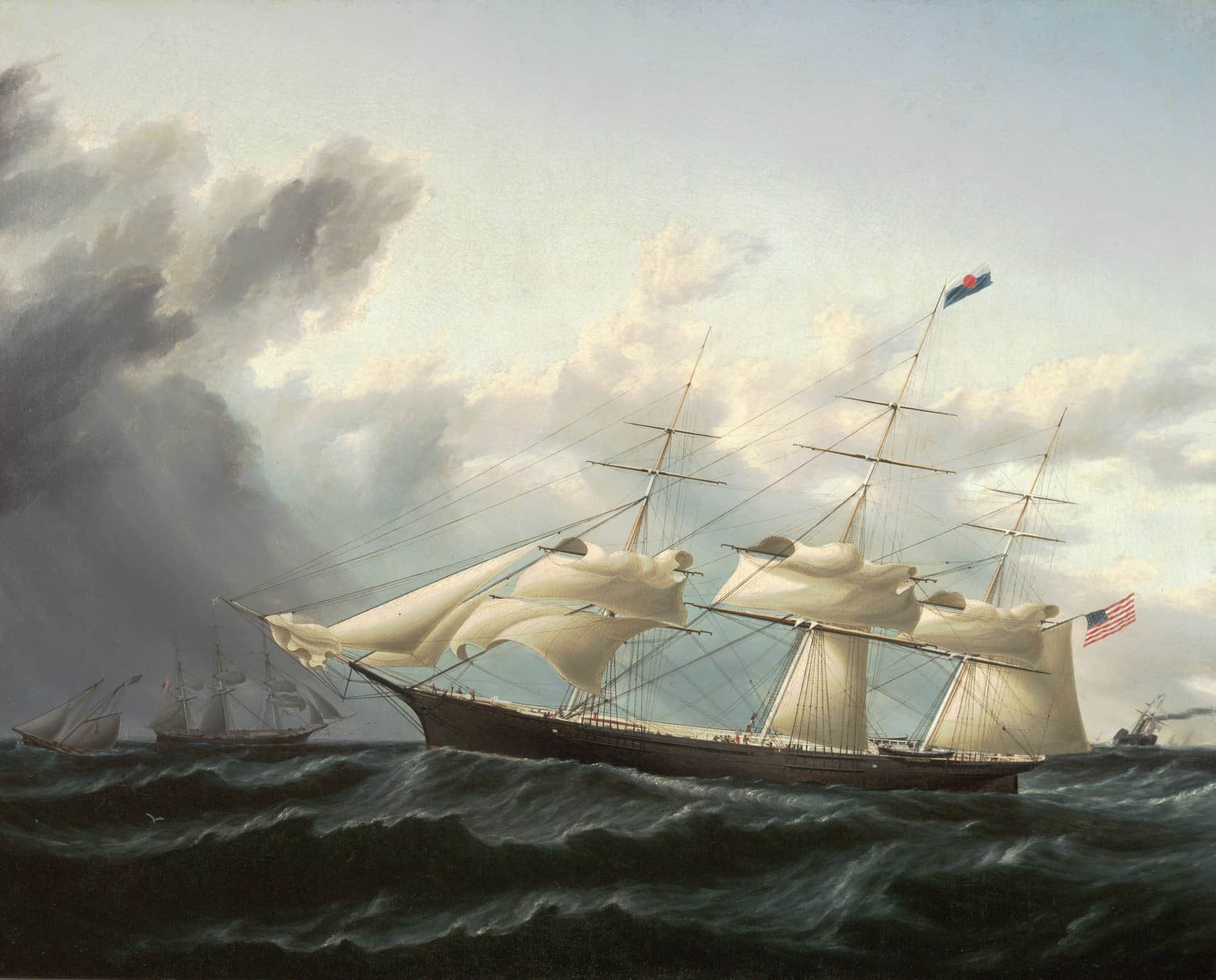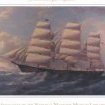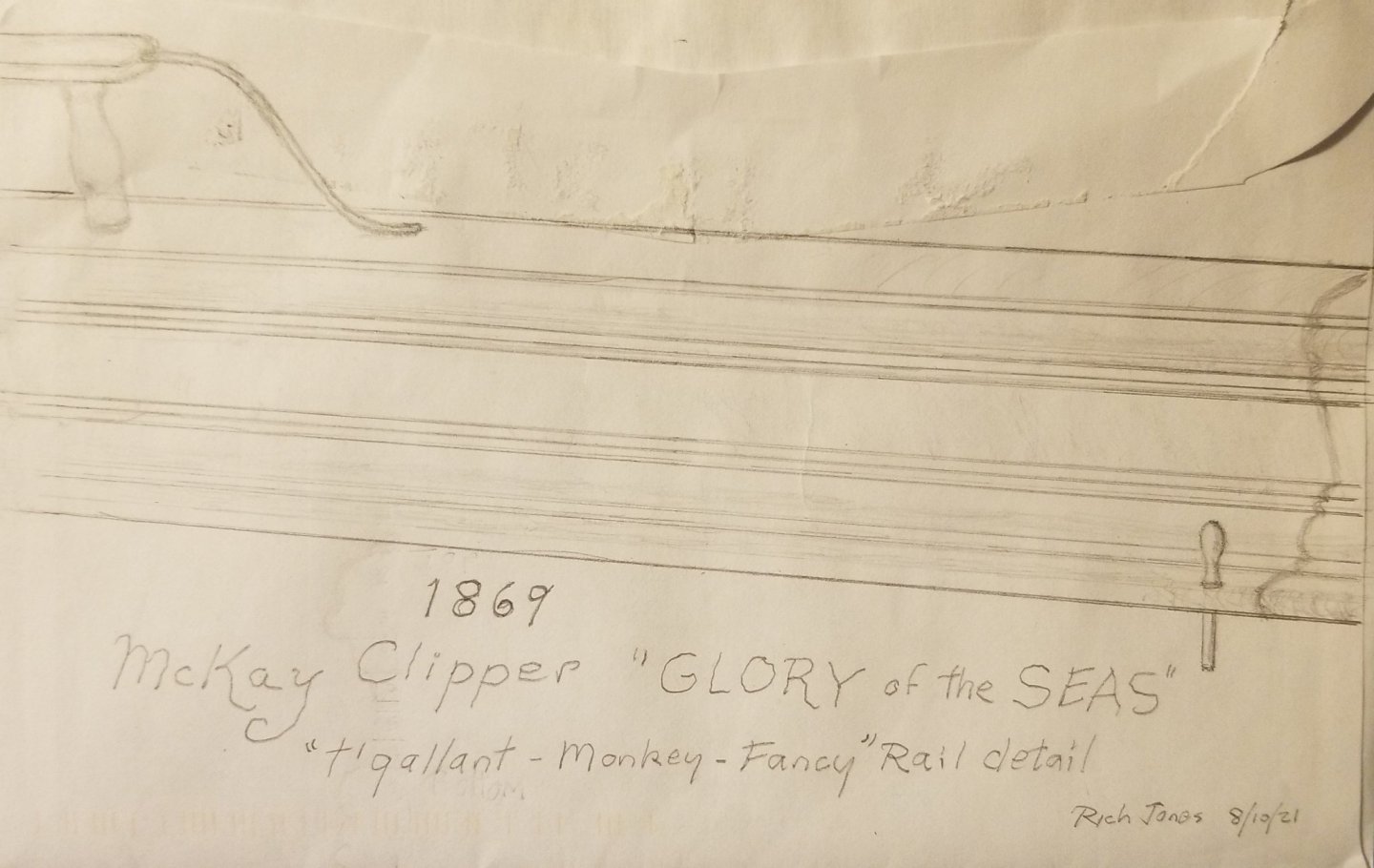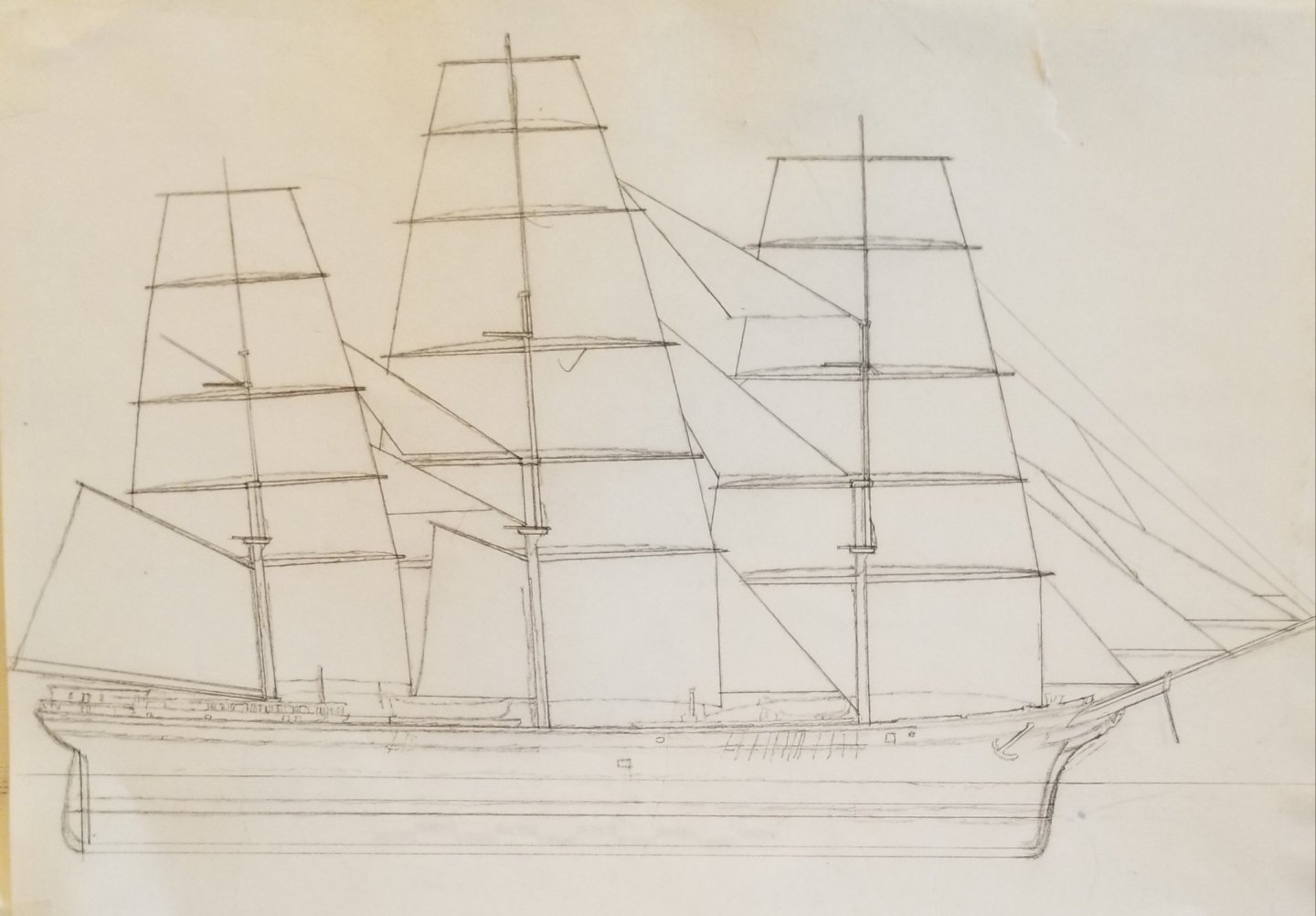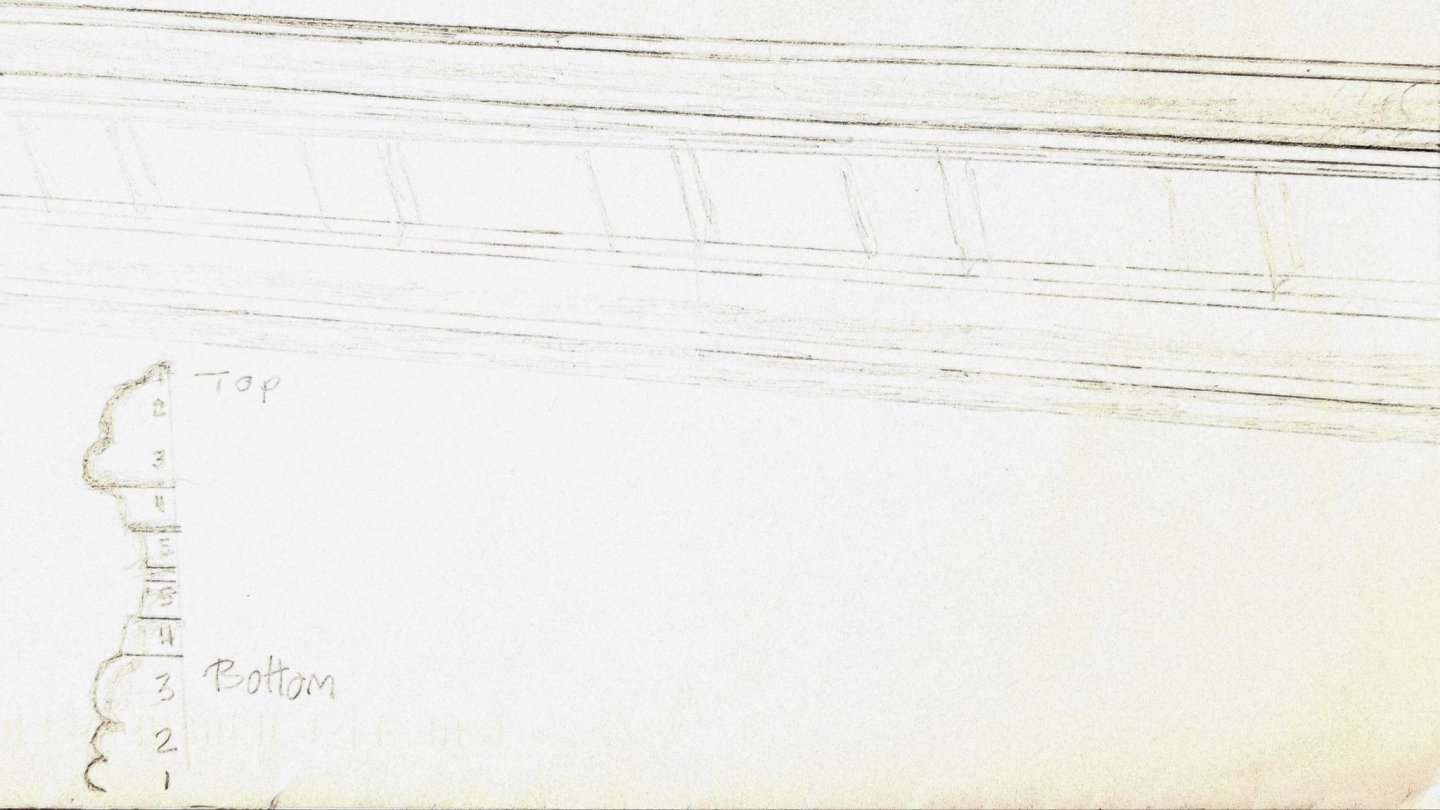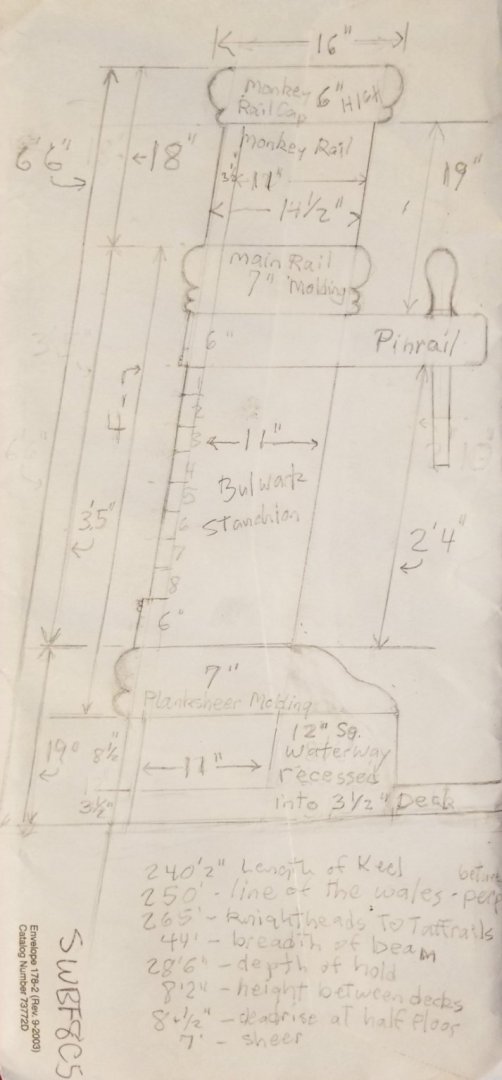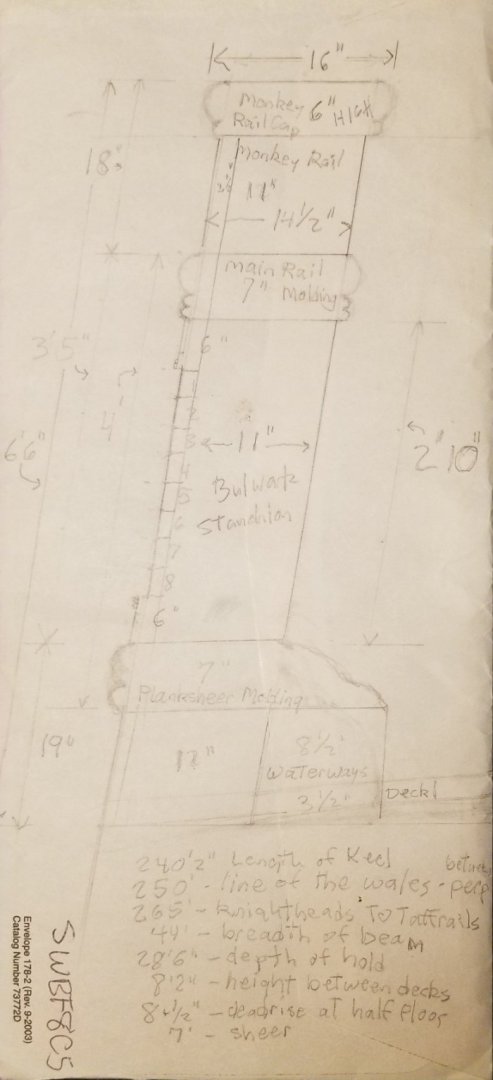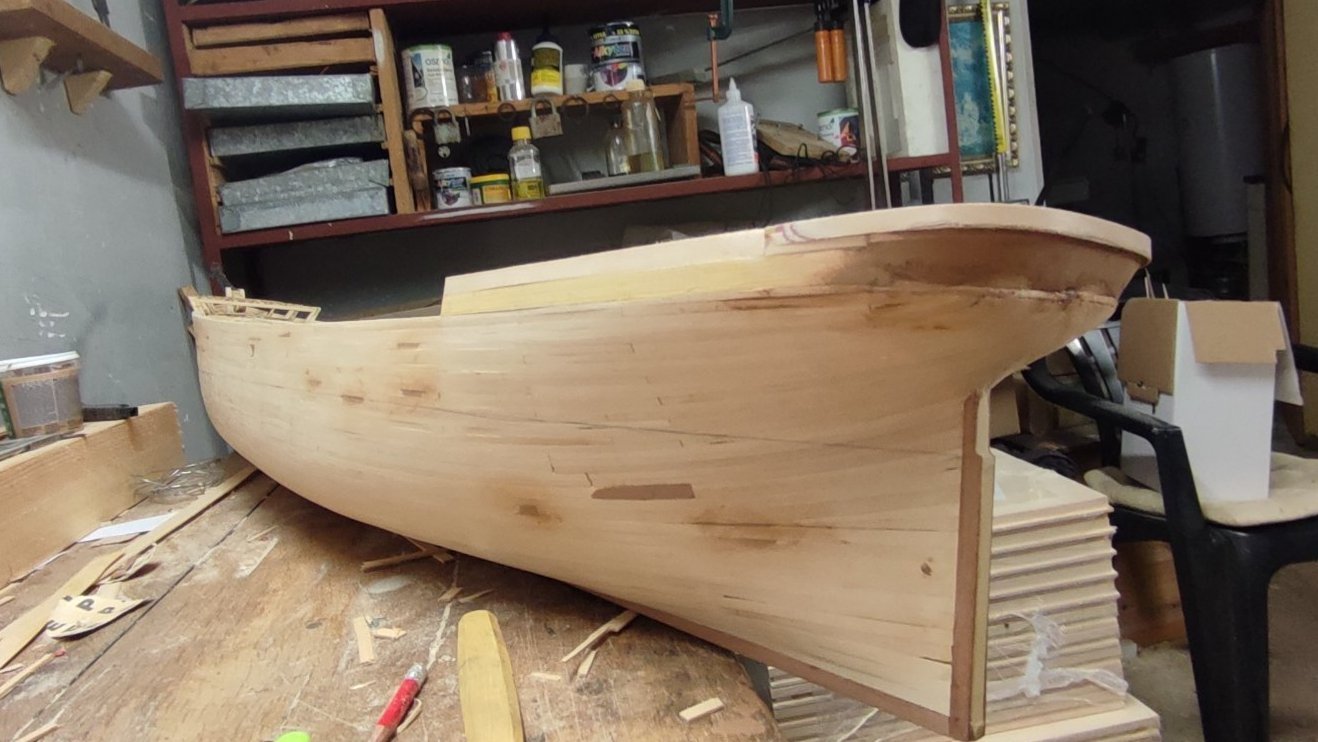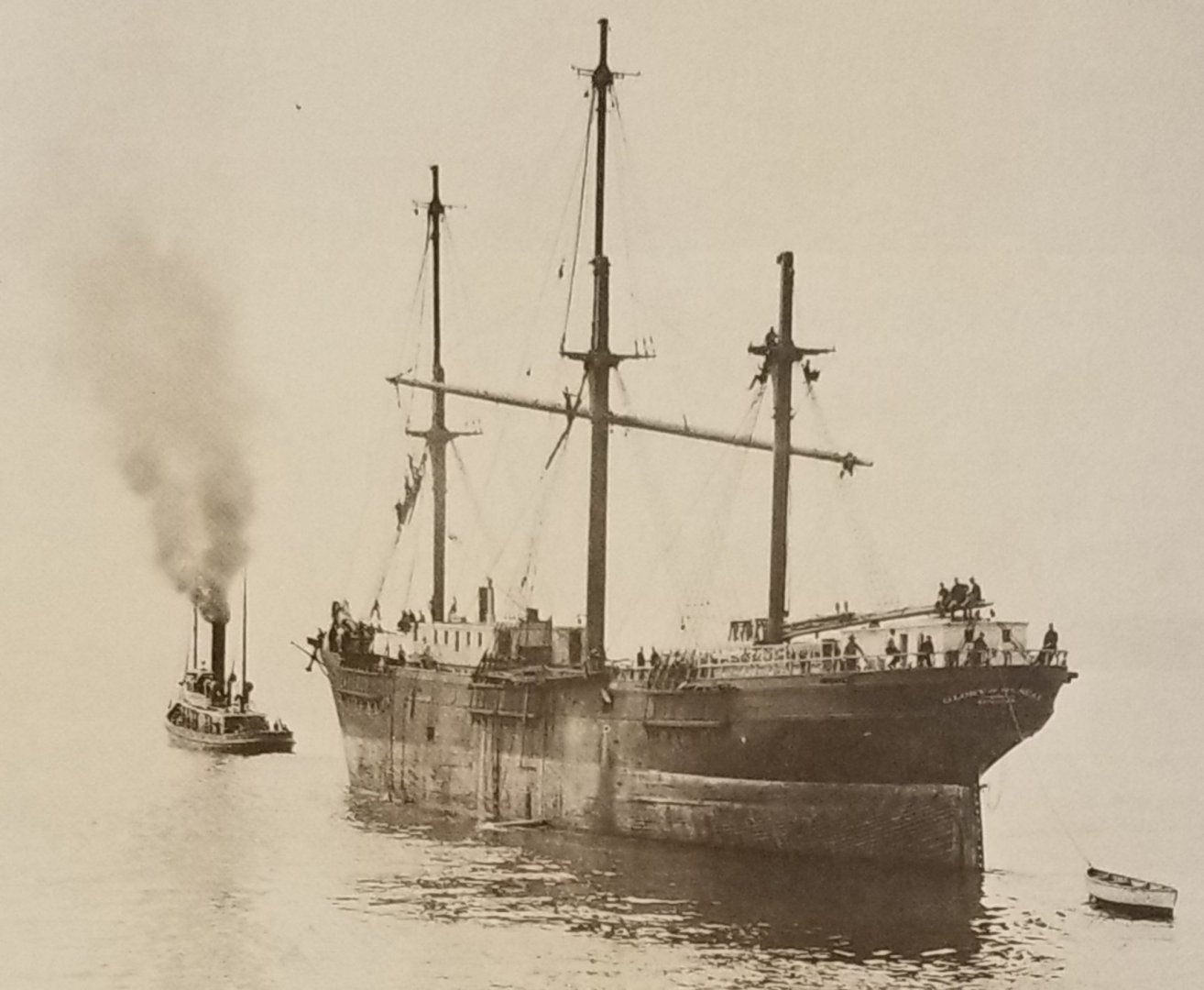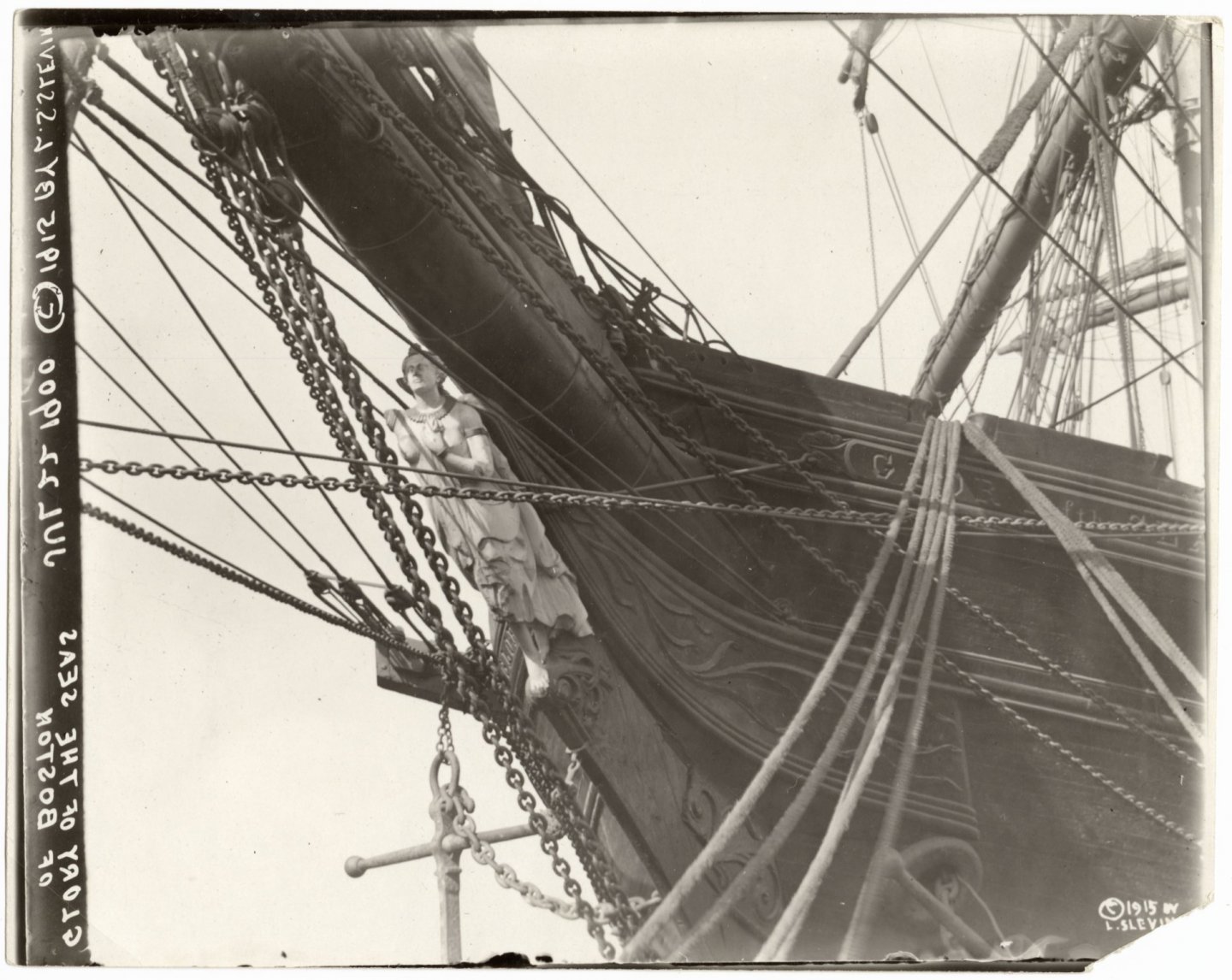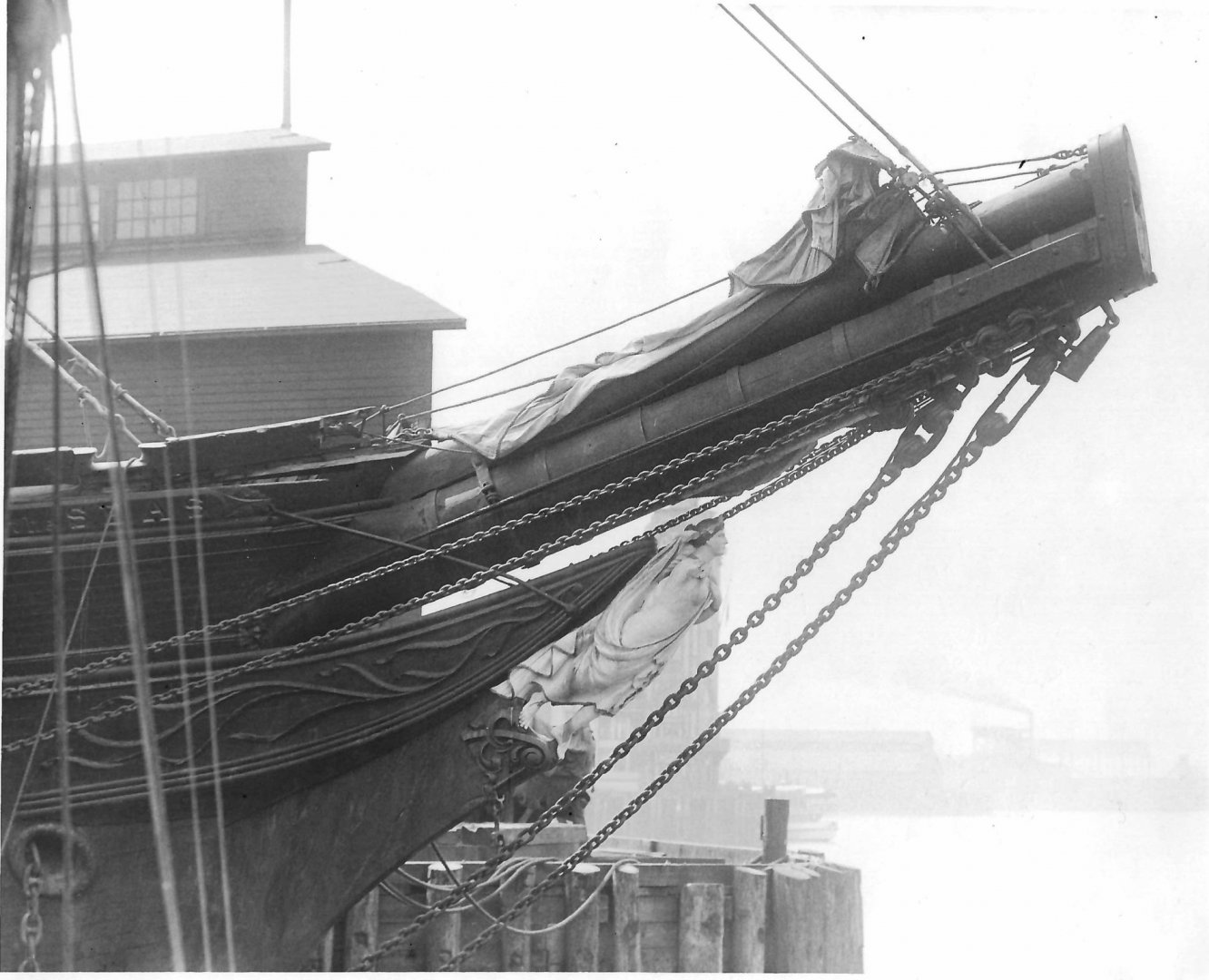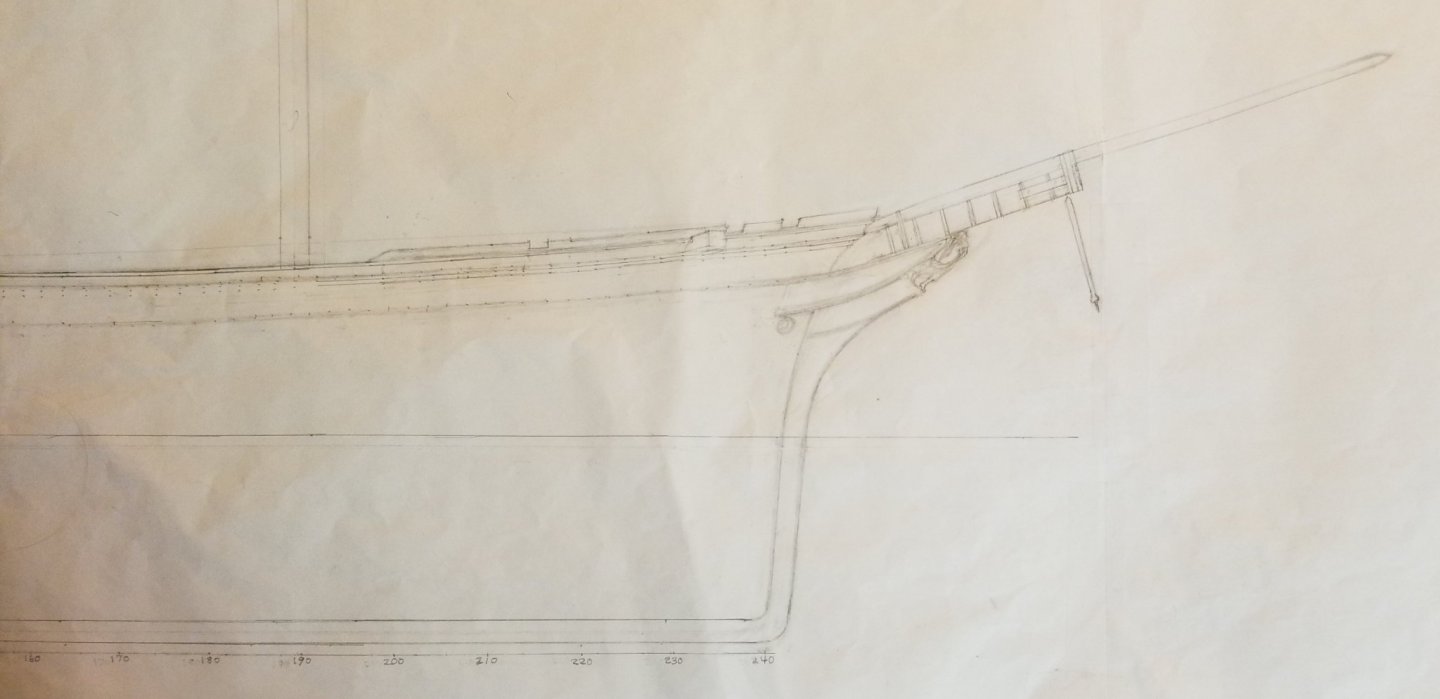-
Posts
2,152 -
Joined
-
Last visited
Content Type
Profiles
Forums
Gallery
Events
Everything posted by ClipperFan
-
Rob thanks. I took a little ill advised "artistic license" to throw in the poop deck rail. I also caught another mistake too. The iron bar doesn't just sit on the top of the t'gallant Rail, it actually bends down and goes straight in, mirroring the way it enters the poop deck Rail. When I have time I'll revise it to reflect how it is on the actual vessel.
-
Vladimir as promised, here is my, ahem revised Artist's impression of Glory's somewhat troublesome and confusing "T'gallant...Monkey...Fancy... Rail" as I can interpret it through somewhat limited images we have of this area of the ship. I have also added the curved Iron Rail which can be seen at the start of her Poop Deck turned Stanchion Railing. Indented line of the rail itself is visible in the picture as well as the inclined angle which is also accurate. It appears the Stanchions follow the curve of the Hull below. They begin slightly chanted inwards, straighten up as they run alongside the Rear Carriage House then cant just slightly outward as they go around the curvature of the Poop itself. Another tricky detail I missed before until Rob pointed it out: the last molding is actually the Pinrail mounted just below the upper Main Rail Molding. It doesn't project much at all, apparently just enough to allow belaying pins to fit inside. Of course, how much, if any of this fancy work you actually want to replicate is entirely up to you. I'm just trying to provide the most accurate information to assist you in your goals to model Glory in all her wonderful details.
-
Rob, I hope you don't mind but I recently discovered a blast from the past. This sketch was taped to a light board my wife bought for me 12 years ago, when I first embarked on my long journey to uncover the genuine appearance of "GLORY of the SEAS." This was when I hadn't yet discovered that, as originally launched, her Mizzen Skysail just barely went above the Main's Royal Yard. It's also years before even a blurry image of San Pedro became available. Still overall, it reveals the mostly accurate direction I was being led to interpret her appearance based on other photos in Mike's first book.
- 3,560 replies
-
- clipper
- hull model
-
(and 2 more)
Tagged with:
-
Rob, based on the 3 images you shared, I owe Vlad an apology for slightly misleading him on the monkey/fancy/t'gallant rail (do you think they had enough names for the same rail? Sheesh!) Anyhow, Vlad I hate to be wrong because it means I misdirected someone, which I never want to do. In my own "shallow" defense, I put too much emphasis on this scene with the ship's boy. Enhanced, there definitely appear to be ribs intersecting the t'gallant rail. However, they do not appear in any other scene which means these must be cast shadows. Most of what else I sketched appears to be correct, with the exception of the (1) top bead which doesn't show up in the clear image of the t'gallant Rail top molding, so that bead must run alongside the lower edge of that upper molding. When I get a chance, I'll submit a revised illustration.
-
Vladimir as promised, a quick sketch of my Artist's impression from the tiny enlarged pics of Glory's bulwarks. Keep in mind, this is entirely of the monkeyrail section (or fancyrail as it's also called). I did a perspective, trying to show how these moldings appear. As usual I'm not too thrilled with the result, so I threw in a rough cross section on the left corner. How I see it is that there are definitely 5 molded sections each, totalling 10 all together. Figuring the molding around the Waterways to be similar would add another 5 for 15 in total. Top of the monkeyrail: (1) thin line looks to be like a bead molding at center top (2) larger molding almost a full circle (3) half sized of larger molding almost looks like the big one above indents to create this one (4) shelf molding is definitely further in, as it's noticeable by cast shadow from above it. (5) a second shelf molding, just slightly shallower than first but otherwise same depth Top of Main Rail Molding at lower end of monkeyrail bulwark: (5) mirror image of shallower shelf molding from above (4) mirror image of thicker shelf molding from above (3) slightly larger but similar round molding to #2 above (2) thicker but otherwise similar round molding to #3 above (1) slightly thicker round molding to #3 above Of course immediately below this would be the pinrail mounted just underneath. While my most recent sketch just showed a featureless pinrail end, it's quite likely like the tables of this era, it too probably had 2 or 3 moldings to it. Nobody's saying you have to model all of these but this is what I can see. Also from the scene with the Ship's Boy, it's vague but you can see stanchions which appear to be 2' apart. So I illustrated them in the perspective sketch.
-
Vladimir, great observation. You are of course correct, interior moldings are even more ornate than exteriors, which is amazing. I will try to sketch them from the enlargements you've shared. As for the Pinrail, it strikes me that it would run across the Bulwarks of the main deck, starting at the Bow just behind the end of the Quarter Deck and terminating at the beginning of the Poop Deck. When you think of it neither of those other decks have need of belaying pins as much as the main deck would. Rob can correct me if I'm wrong.
-
Rob, per your confirmation of Glory's Pinrail location, submitted here for your review is my revised bulkhead cross section with appropriate Pinrail included. I also cleaned up some of the dimensional call outs to be less confusing. And.... wouldn't you know it, as soon as I posted this sketch, I spotted an error. So it's been re, revised to indicate more accurately that from the exterior, the Planskeer Molding is actually 8 1/2" above the deck line, since the Waterways are recessed 3 1/2" into the Deck Beams.
-
George, placing tiny scale flat plates on a curving surface has got to tax your patience for sure. I don't envy you but the results of such practiced tedium will certainly be worth it.
- 602 replies
-
- Flying Fish
- Model Shipways
-
(and 2 more)
Tagged with:
-
Rob, there are two illustrations of pinrail mountings. Detail F: continuous carved panel (clamp?) between Main Rail Molding then Pinrail is mounted inside to Intermediate Rail. Is that the same as Sheerail? Detail J: pinrail is mounted inside directly below Main Rail Molding. Did Glory have both styles or just the one? From photos it looks like she had detail F style. Your thoughts?
-
Vladimir now for something completely different. Since you mentioned doing the Sheerline moldings, I thought you might appreciate seeing this. Here, as best envisioned by me, is a cross section of Glory's Port side bulwarks looking Foreward, with interior dimensions on the right and exterior on left. I tried to incorporate every visible molding as can be determined by many photos available. Interestingly enough, when the 3" wide Main Bulwarks strakes are counted, there are exactly 8 visible between the 2 6" wide shelfs (for lack of a better description) which mirror each other top and bottom. All dimensions are, as usual taken directly from MacLean's 1869 highly detailed specs most likely supplied directly by McKay's Shipyard.
-
Tony Hunt when you describe "GLORY of the SEAS" as massive grace you are really capturing one of the most defining characteristics of Donald McKay's vessels. They were huge in comparison to their contemporaries. Yet as you so astutely pointed out, while these were enormous Ships, they were incredibly graceful and beautifully finished too. Many contemporary newspaper accounts describe that whenever Glory sailed into Port she was one of the most popular Clippers to be seen. Rob and Vladimir are both being very faithful to McKay's longest lived final Clipper.
- 3,560 replies
-
- clipper
- hull model
-
(and 2 more)
Tagged with:
-
Rob, she does indeed resemble the San Pedro scene. More visual confirmation that your reconstruction of Glory is spot on!
- 3,560 replies
-
- clipper
- hull model
-
(and 2 more)
Tagged with:
-
Rob, I seriously doubt anyone will notice it. Only annoying perfectionists like myself, which fortunately isn't a large percent of the population! Meanwhile, though I bet most Sailing Ships would have something similar. It makes sense not to have either spar able to rotate in strong winds or heavy seas.
- 3,560 replies
-
- clipper
- hull model
-
(and 2 more)
Tagged with:
-
Rob this is definitely an improvement for the Bowsprit dimension. I'm going to highlight another fascinating feature of the inner Jibboom, which you might like to incorporate too (or not, if it's too much of a bother). Like the Bowsprit below, the Jibboom transitions from round to oblong a few feet before it enters the corresponding rectangular slit in the monkeyrail Bulwarks. I think we discussed this finding a few months back. Note the arrow shaped shadow at band 3 above Goddess 'Athene's' head? That's where the inner Jibboom is squaring off. In the 1911 Seattle bow close up, it also appears to slant down gradually from that same location. This is tougher to see since it's hidden by the jib sails resting on it. Since the monkeyrail height is 18" and this spar is at least 19" maybe even 20" that would be necessary to accomodate the smaller opening.
- 3,560 replies
-
- clipper
- hull model
-
(and 2 more)
Tagged with:
-
Rob, no problem. Meanwhile I'm just amazed at your single piece Bowsprit Cap!
- 3,560 replies
-
- clipper
- hull model
-
(and 2 more)
Tagged with:
-
Rob, when looking at your proposed new spar I immediately see a scale problem, which I hope my observations can help you identify and correct. The flattening of the top part of the Bowsprit on Glory is about 18" (3/16ths") from the top of the main bulwark Rail, then Band 1 is about 1' (1/8th") of that distance. Your new spar doesn't allow for that, so where you've sketched your first band is too close scale wise. From your measurements, we know that 7 bands are 3' (3/8ths") apart, center to center, it looks like the distance from the center of band 7 to inside the Cap is 18". The Cap itself also appears to be 18" since it seems to match the distance from band 7. That would make your Bowsprit a minimum of 3 3/16ths" to comfortably include a mounting point for the Cap. You might want to sketch out the entire Bowsprit on paper, leaving extra length to accomodate the entrance into the Bow. I hope this helps.
- 3,560 replies
-
- clipper
- hull model
-
(and 2 more)
Tagged with:
-
Rob, great catch to see that relatively slim detail. Initially I was so impressed with the overall look that I completely missed it. In the future, if you'd like me to 'backstop' your calculations (you or Vlad) I would gladly give you the most accurate calculations I can generate. As carpenters always say "measure twice, cut once." Of course, this is in no way my attempt to interfere in any way on either of your plans but only to offer my assistance.
- 3,560 replies
-
- clipper
- hull model
-
(and 2 more)
Tagged with:
-
Rob, when the two combined are complete, the upper Jibboom will fit neatly into the 18" monkeyrail with the cut down area joining the top evenly. As the Jibboom sits now on your model, it is just slightly below the joint of the monkeyrail. When your Bowsprit is scaled to 34" this should move your Jibboom up properly to match with the top of the monkeyrail, as seen in this 1911 Seattle Bow close up.
- 3,560 replies
-
- clipper
- hull model
-
(and 2 more)
Tagged with:
-
Rob, Vladimir according to Duncan MacLean's description from 1869 the Bowsprit's dimensions were 24' inside of the Cap and 34" wide. While the Jibboom isn't described by width, I measured the dimensions of the 1911 Seattle Bow close up, I got 7/8ths" for the Bowsprit & 1/2" for the upper Jibboom. Dividing 4/8ths (1/2) by 7/8ths or simply 4 ÷ 7 =.57 x 34" = 19". In 1:96 scale, 34" = apprx 10/16ths" & 19" = about 7/16ths". Here's my sketch of the Bow at 1:96th scale 1/8ths" = 1'.
- 3,560 replies
-
- clipper
- hull model
-
(and 2 more)
Tagged with:
-
Vladimir, the gap between your Bowsprit and Naval Hood profile below hopefully should be closed by the time all your rigging is done. We see this space in numerous pictures of Glory after her long Jibboom is cut off. If you look at the scenes of Glory when she's fully rigged, there's almost no space between the Bowsprit and Naval Hoods, as it was cinched tight for seaworthiness.
About us
Modelshipworld - Advancing Ship Modeling through Research
SSL Secured
Your security is important for us so this Website is SSL-Secured
NRG Mailing Address
Nautical Research Guild
237 South Lincoln Street
Westmont IL, 60559-1917
Model Ship World ® and the MSW logo are Registered Trademarks, and belong to the Nautical Research Guild (United States Patent and Trademark Office: No. 6,929,264 & No. 6,929,274, registered Dec. 20, 2022)
Helpful Links
About the NRG
If you enjoy building ship models that are historically accurate as well as beautiful, then The Nautical Research Guild (NRG) is just right for you.
The Guild is a non-profit educational organization whose mission is to “Advance Ship Modeling Through Research”. We provide support to our members in their efforts to raise the quality of their model ships.
The Nautical Research Guild has published our world-renowned quarterly magazine, The Nautical Research Journal, since 1955. The pages of the Journal are full of articles by accomplished ship modelers who show you how they create those exquisite details on their models, and by maritime historians who show you the correct details to build. The Journal is available in both print and digital editions. Go to the NRG web site (www.thenrg.org) to download a complimentary digital copy of the Journal. The NRG also publishes plan sets, books and compilations of back issues of the Journal and the former Ships in Scale and Model Ship Builder magazines.

